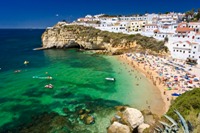

Published on : Wednesday, May 11, 2022

The Spanish holiday destination and also popular to international tourists, Costa del Sol is on high alert over the Nile virus, a deadly disease transmitted by a mosquito, after it killed eight people last summer.
Last year, 87 people were affected by the virus in Andalusia, the region where Costa del Sol is located in the south of Spain, and eight were killed. The Andalusian Government has decided to act now as some regions are currently at high risk.
According to health officials in Spain, the highest level is recorded in Benahavís, in Malaga. The authorities are implementing prevention plans as well as surveillance and control measures in these regions. The Nile virus is generally transmitted by mosquitos that bite birds, which carry the virus and deposit it in both humans and horses.
The Centers for Disease Control and Prevention said that the West Nile virus (WNV) is the leading cause of mosquito-borne disease in the continental United States. It is most commonly spread to people by the bite of an infected mosquito. Cases of WNV occur during mosquito season, which starts in the summer and continues through fall.
The NHS explained that some people develop mild flu-like symptoms, a skin rash and may feel sick. The infection usually goes away on its own without treatment. The virus is not contagious. You only get it from being bitten by an infected mosquito.
Areas at high risk of Nile virus circulation in the areas are Tarifa, Cádiz; Barbate, Cádiz; Benalup-Casas Viejas, Cádiz; Conil de la Frontera, Cádiz; Medina Sidonia, Cádiz; El Puerto de Santa María, Cádiz; Puerto Real, Cádiz; Vejer de la Frontera, Cádiz; Jerez de la Frontera, Cádiz; San José del Valle, Cádiz; Sanlúcar de Barrameda, Cádiz; Trebujena, Cádiz; Bornos, Cádiz; Moguer, Huelva; La Palma del Condado, Huelva; San Bartolomé de la Torre, Huelva; Aljaraque, Huelva; Huelva, Huelva; Lepe, Huelva; Santa Bárbara de Casa, Huelva; Lopera, Jaén; Benahavís, Málaga; Almensilla, Sevilla; Bollullos de la Mitación, Sevilla; Bormujos, Sevilla; Camas, Sevilla; Castilleja de la Cuesta, Sevilla; Coria del Río, Sevilla; Gelves, Sevilla; Mairena del Aljarafe, Sevilla; Palomares del Río, Sevilla and La Puebla del Río, Sevilla; San Juan de Aznalfarache, Sevilla; Sanlúcar la Mayor, Sevilla; Tomares, Sevilla; Villamanrique de la Condesa, Sevilla; Sevilla, Sevilla; Carmona, Sevilla; Castilblanco de los Arroyos, Sevilla; Mairena del Alcor, Sevilla; Alcalá de Guadaíra, Sevilla; Las Cabezas de San Juan, Sevilla; Dos Hermanas, Sevilla; Lebrija, Sevilla; Morón de la Frontera, Sevilla; Los Palacios y Villafranca, Sevilla; Utrera, Sevilla
These areas are being advised to promote specific prevention plans to minimise the possible impact of infections in humans.
In addition to the urban disinfections, communication plans about the preventive measures will also be put in place.
Now, the British tourists visiting these areas are being advised to follow the local Government’s prevention and safety measures.
Minister of Health and Families of the Junta de Andalucía, Jesús Aguirre, said that the publication of a risk map was “a preventive diagnosis”, as no cases have been registered this year yet.
Tags: Europe, spain, Tourism, Tourism in Spain
| ||||
    | ||||
  | ||||